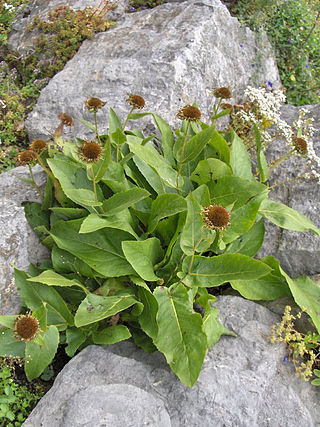
Telekia is a genus of flowering plant, of the family Asteraceae.

Volkameria is a genus of flowering plants in the family Lamiaceae. It is pantropical in distribution. Many of the species are found in coastal habitats.
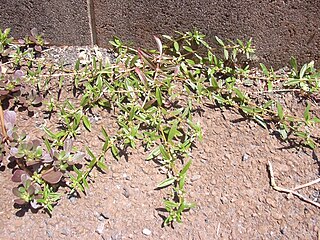
Oldenlandia is a genus of flowering plants in the family Rubiaceae. It is pantropical in distribution and has about 240 species. The type species for the genus is Oldenlandia corymbosa.

Asteriscus is a genus of flowering plants in the family Asteraceae.

Distephanus is a genus of flowering plants in the family Asteraceae. It is described by American botanist Harold E. Robinson as having over 40 species and by David Mabberley as having only 34 species. These sources differ sharply in their description of the range of the genus. Robinson has it ranging throughout Africa and occurring also in India and China. Mabberley has it restricted to southeast Africa, Madagascar, and Mauritius.
Eremothamnus is a monotypic genus of shrubs in the family Asteraceae. Its only species is Eremothamnus marlothianus. It is native to the coastal desert of Namibia. It is a small shrub with spiny leaves.

Kohautia is a genus of flowering plants in the family Rubiaceae. They are native to tropical areas of Asia, Africa, and Madagascar. Thirty-one species are known. The type species for the genus is Kohautia senegalensis.

The Cichorioideae are a subfamily of the family Asteraceae of flowering plants. Familiar members of Cichorioideae include lettuce, dandelions, chicory and Gazania species. The subfamily comprises about 240 genera and about 2900 species. It is heterogeneous and hard to characterize except with molecular characters.
Erato is a genus of flowering plants belonging to tribe Liabeae of the family Asteraceae. It is found from Costa Rica to Bolivia, with its main centre of diversity in Ecuador.

Bigelowia is a genus of North American flowering plants in the family Asteraceae, native to the United States.

Corethrogyne is a genus of flowering plants in the family Asteraceae.
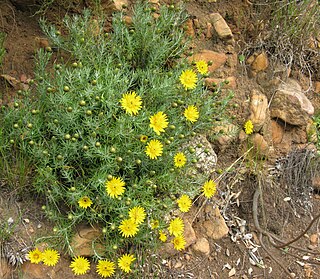
Heterolepis is a genus of flowering plants in the sunflower family. It has three or four species, all endemic to the Western Cape Province in South Africa.
Hoplophyllum is a genus of flowering plants in the family Asteraceae. It has two species, Hoplophyllum spinosum and Hoplophyllum ferox, both native to South Africa.
Marasmodes is a genus of South African shrubs in the chamomile tribe within the daisy family. It is endemic to the Cape Provinces of South Africa.
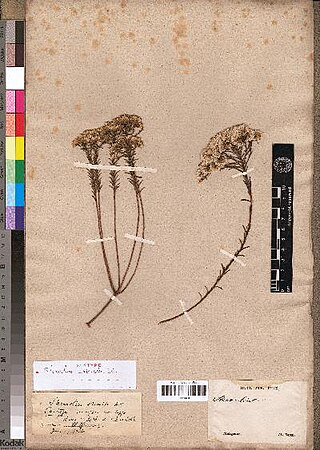
Stenocline is a genus of flowering plants in the tribe Gnaphalieae within the family Asteraceae.
Stilpnogyne is a genus of flowering plants in the groundsel tribe within the sunflower family.

Kadua is a genus of flowering plants in the family Rubiaceae. It comprises 29 species, all restricted to Polynesia. Twenty-two of these are endemic to the Hawaiian Islands. Some of the species are common at high elevation. Others are single-island endemics or very rare, and a few are probably extinct. Kadua affinis is widely distributed in Hawaii and is polymorphic. The type species for the genus is Kadua acuminata.
Chione is a monotypic genus of flowering plants in the family Rubiaceae containing the single species Chione venosa. It is native to the neotropics, occurring in most of Mexico, and throughout Central America, the Caribbean, Colombia, Ecuador, and Peru. It is typically a tree growing 10 to 20 meters tall. In harsh habitats, it may be dwarfed and shrubby. It has no known economic use.
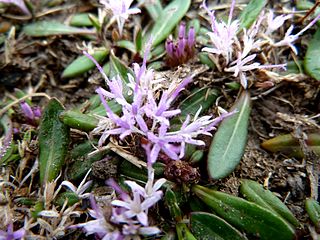
Platycarpheae is a tribe of the Asteraceae that is native to Namibia and South Africa. The tribe contains two genera and a total of three species.
Ekmanianthe is a genus of flowering plants in the family Bignoniaceae. It is most closely related to Tabebuia and has sometimes been included within it. It consists of two species of trees, neither of which is especially common in any part of its range:












